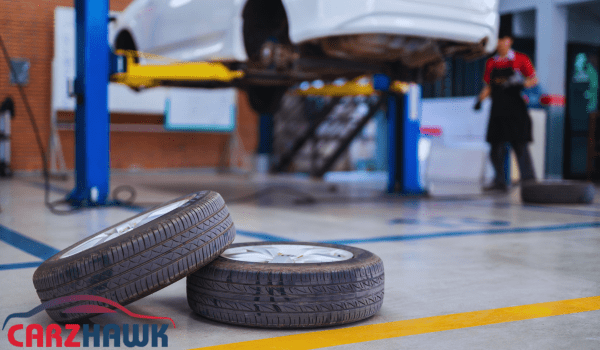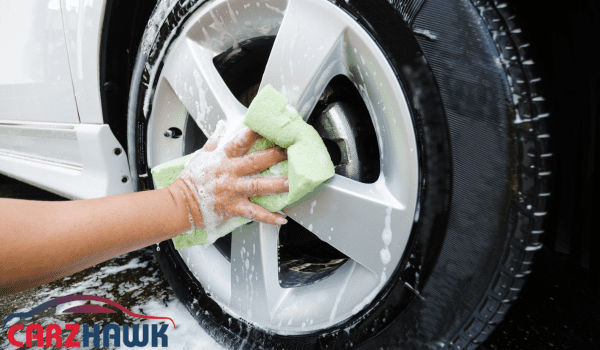As you drive along, suddenly, you feel a thump, and the car starts shaking. When you stop, you see a big screw stuck in the tread your tire. Oh no, what now? So, Found a Screw In Your Tire? Here is what to Do?
It’s not fun to find a screw or nail stuck in your tire, but don’t worry too much about it. If this sounds like you, keep reading to find out What to do.
Found a Screw In Your Tire? What You Should Not Do
If you can see the nail or screw that’s creating the problem in your tire, it’s VERY important to resist the urge to pull it out right away.
This is because doing so might cause the tire pressure to drop much more quickly since the screw itself acts as a plug while staying in place.
What to Do If Your Tire Has a Screw In It
When fixing a newly found screw in your tire, the following things should be thought about. Taking these things into account will help you figure out exactly what needs to be fixed.
On the Go vs. At Home
If you are on the road when a screw-related break is found, you will have to make a very important decision. The tire should be safe to drive to the local tire shop for repair if there is little to no air loss when the pressure is checked.
If, on the other hand, the damaged tire has already started to go flat, you will need to put on the spare tire or use a tire plug kit and portable tire compressor to fix the tire while you are still on the road.
In these cases, it’s important to note that Slime or Fix-A-Flat products shouldn’t be used on wheels with TPMS.
It’s always best to play it safe and put it on the car’s spare tire when this kind of puncture is found at home. Alternatively, if there is no extra tire available, the vehicle can be jacked up, and the flat tire can be taken off. This tire gets repaired from a nearby shop.
Whether it leaks or not
There are different kinds of screw holes. Some don’t even make it to the inner tube of a tire, so they don’t actually cause a leak.
If there is a screw-related hole, use soapy water from a spray bottle to check a real leak. Generously spray the screw and watch for signs of bubbling that will get worse over time. This boiling would mean that there is a real leak.
Where the Screw Is (Tread, Shoulder, or Sidewall)
It’s too bad that not all punctures can be fixed. It’s only safe to patch holes that are directly in the tread of a tire, if hole isn’t too big.
Any holes in a tire that start in the shoulder or sidewall are very dangerous and need to be replaced with a new one. It is usually not possible to fix a hole that is closer than two finger widths to the shoulder of the tire.
How deep the screw is (puncture vs. outer tread layer)
Every single screw doesn’t make deep holes. One screw might go deep enough to damage the inner tube of a tire, while another might only go a little deeper than the tread on the outside, so there is no real leak.
In this case, you should use soapy water or glass cleaner, as explained above, to find out how bad the break really is. If these tests don’t show a leak, the screw that’s causing the problem should be turned counterclockwise to get it off the tread of the tire.
How did that screw get there?
There are several ways for a screw to get into a tire. But in almost all cases, this kind of accident starts with the loss of building supplies by the side of the road.
Because of this, you may notice that there are more flat tires in areas that are just starting to grow, like in new subdivisions, industrial parks, or neighborhoods.
If you lose or throw away screws, they will get driven into a tire whenever the vehicle, under its own weight, hits them. This happens when a much heavier car drives over a tire that is at a right angle to the road. The screw punctures the car.
How long can you drive with a flat tire?
In each case, the distance that can be driven with a screw in a tire is different. As was already said, a screw can often be used as a homemade plug while it is still in the damaged tire.
Still, a certain amount of air loss happens almost every time. The air loss will speed up the tire going flat the more air it has.
Any way you look at it, a flat tire needs to be fixed right away. If one or more of your tires are in this condition, you should only try to drive for a short amount of time. If you feel unsafe fixing these things yourself, you should take your car to a reputable tire shop as soon as possible.
Change vs. Repair
Should you fix or replace a tire that a screw has damaged? That usually depends on where the screw is and how good the tire is overall.
If the hole is right in the tread and the tread is deep enough, repair is the best choice.
But if the nail is in the shoulder or sidewall of the tire, the tire has to be replaced.
Also, purchase a new tire if the existing one has big holes. In fact, most tire shops will only fix tires that are in pretty good shape.
It’s best to change both tires on the same axle at the same time so that they have the same amount of tread. The way you drive can be very different if your tires are of other brands or have very different tread depths.
For the same reason, you should change all four tires on an all-wheel-drive car. Check your owner’s manual; it should have suggestions based on how much tread is remaining on your tires.
How Should You Handle a Nail in a Tire?
The nail in a tire is removable just like a screw or something. People should usually act faster when they need these kinds of repairs.
Unlike nails, screw has threads, which means it can be thrown off of a tire’s tread by centrifugal force. Because of this, it should be even more important to get repairs done quickly.
How much does it cost to fix a screw in a tire?
Fixing a tire that a screw has damaged usually doesn’t cost much. Most shops will charge around $20 to fix a car tire because the job is pretty easy and quick.
Some tire shops, like Discount Tire or Les Schwab, will do this for free to make things easier for you.
Should you use a do-it-yourself tire repair kit?
This kits can be very helpful if you need to fix your tire on the roadside. But they can’t replace a good “tire-off” repair like the ones done at most tire shops.
Tire shops almost always use patch/plug combinations, which make the internal/external fix more stable. Do-it-yourself repair kits, on the other hand, usually come with rope plugs that fill the hole left by the screw.
Do they cover damage to the tire from a screw?
In some cases, people with full or comprehensive car insurance get compensations. But it’s important to remember that the chances of this happening often change from policy to policy. A quick call to your insurance agent should clear things up if you deserve a benefit.
Also worth mentioning is that a lot of tire shops and tire makers offer extra road hazard warranties that cover the costs of fixing and replacing tires that get punctured. Check with the store that sold you the tires before paying for any of these kinds of services.








